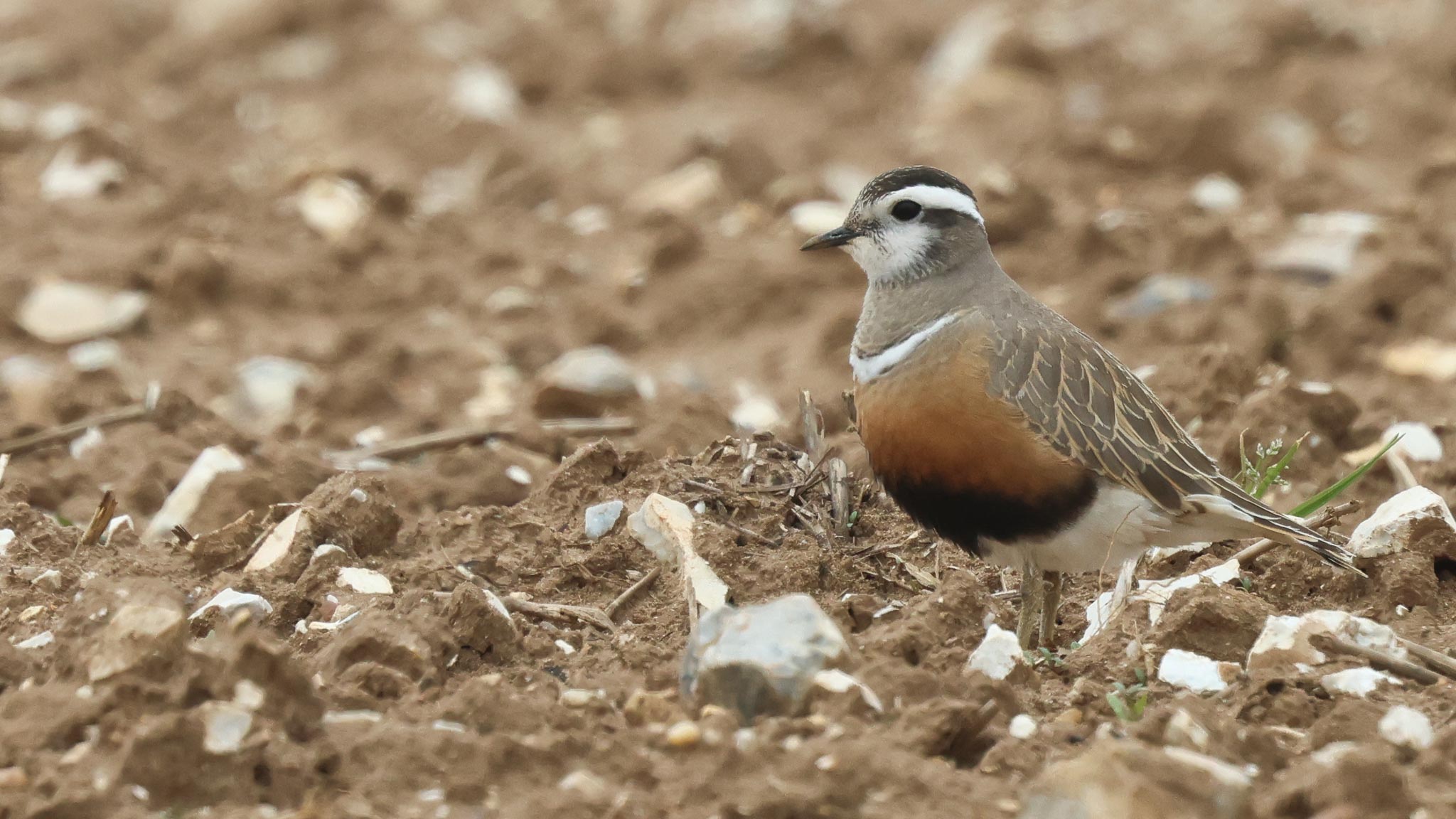Happy New Year! The first tour of 2022 today, an Owl Tour in North Norfolk. The weather was kind to us, after frost overnight it was clear, bright and sunny for most of the day, just clouding over in the afternoon, with a few spits of rain just as we were packing up.
It was an early start to try to catch a Barn Owl still out hunting, before going in to roost for the day. We drove straight over and round via some meadows where there have been one or two Barn Owls in recent days, but on our first circuit we drew a blank. Undeterred, we carried on searching and found one down in the grass in one of the fields.
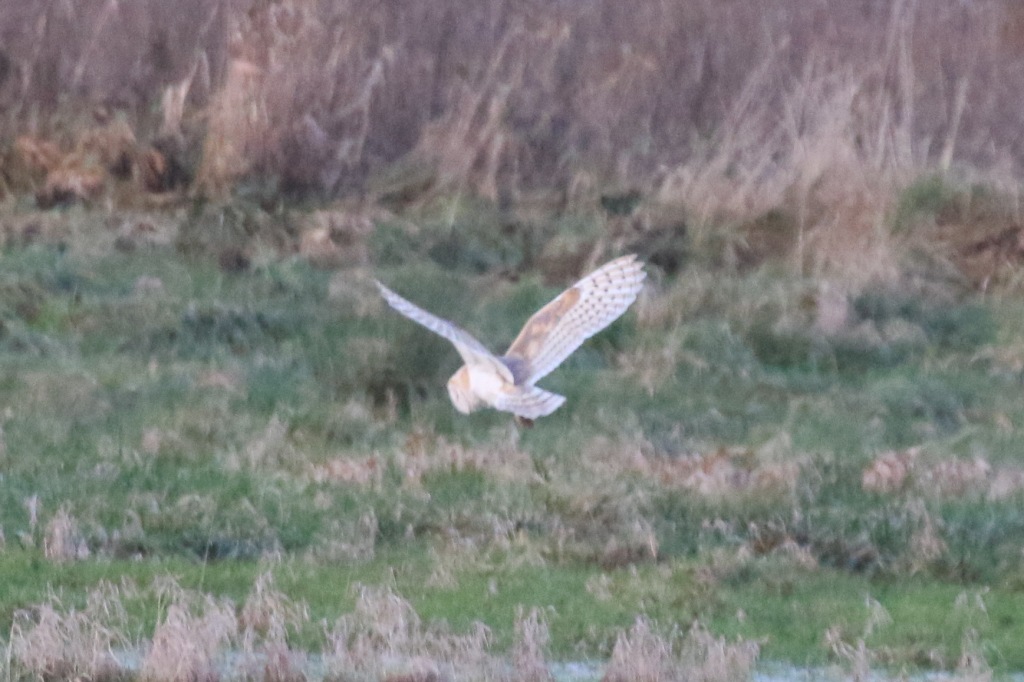
We stopped and got out of the minibus and could see the Barn Owl’s head sticking out above the vegetation, looking round. It took off and flew past us, but we lost sight of it behind a thick hedge. We walked up and found it again from the next gateway, hunting over another wet meadow, but it flew back and through the next hedge out of view again.
Further along again and this time we had a great view. We could see the Barn Owl clearly now, doing circuits round over the long frosty grass. It kept dropping down but always looked rather half-hearted and quickly came back up with empty talons. When it suddenly banked and dropped down into the grass again, this time it stayed on the ground for several minutes. It was behind a thick clump of rushes, but we could just see its head come up from time to time, looking round nervously. When it finally came up again, we could see it had a vole in its talons.
The Barn Owl flew across purposefully to a nearby hedge, still carrying the vole, and landed rather clumsily in the brambles at the base. With wings outspread it balanced rather unceremoniously, eventually managing to transfer the vole to its bill and turn around. We had a great view of it now through the scope.
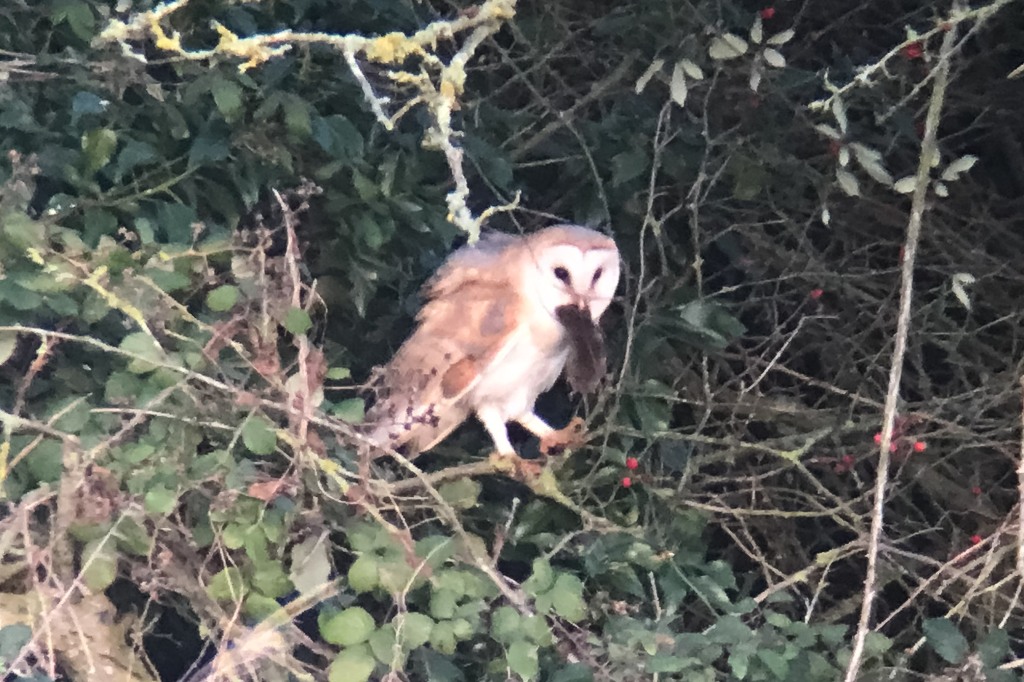
After a while, the Barn Owl flew up into the hedge and disappeared, presumably heading into roost with its meal. We moved on – we had a quick look in the fields on our drive back round, but it seemed like the morning Barn Owl session was over here.
We drove inland to look for Little Owls next, and this time we were immediately in luck. As we pulled up by some farm buildings, we could see two Little Owls sunning themselves on the roof of a barn. We parked out of sight of them and walked carefully round to where we could watch them from a distance. Now we had great views through the scope.
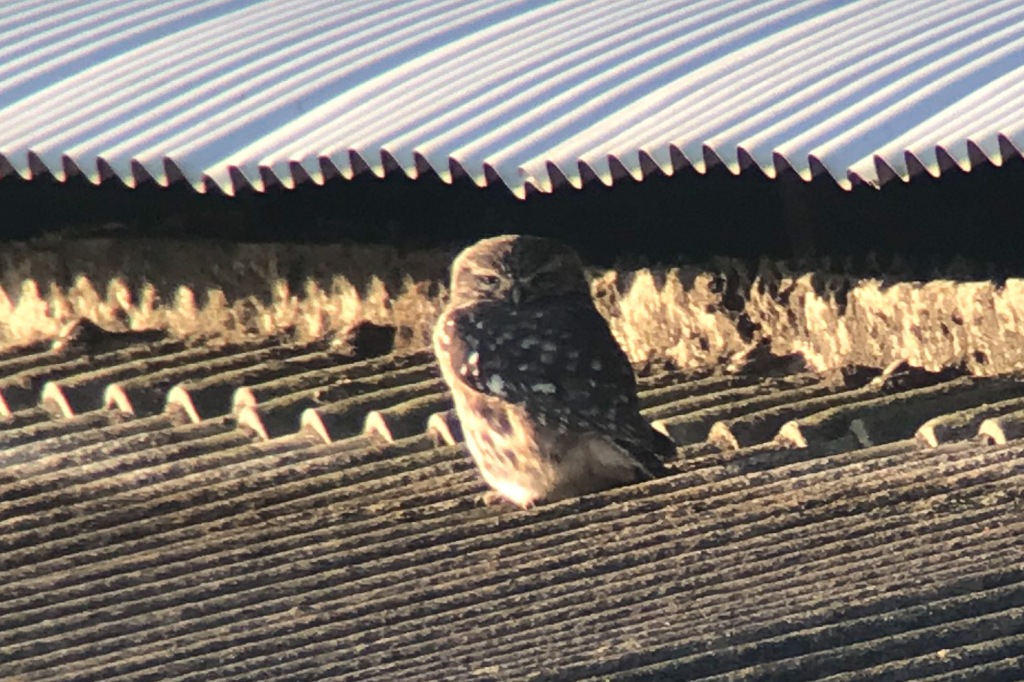
The Little Owls seemed unconcerned at first by all the activity around them, traffic passing on the road, a couple of horse riders riding past, a farm worker going in to the yard past them. But first one shot in and disappeared under the roof and eventually the second followed too. We took that as our cue to move on and walked back to the minibus. As we drove away, we could see one was already back out again – it was a perfect morning for them, with the low sunshine hitting the top of the roof.
We hadn’t gone very far when we spotted another Barn Owl still out hunting, flying round over a rough field beside the road, so we parked again and got out to watch it. It did a couple of circuits further back then flew straight towards us, coming past at close quarters, a fantastic sight in the sunshine.
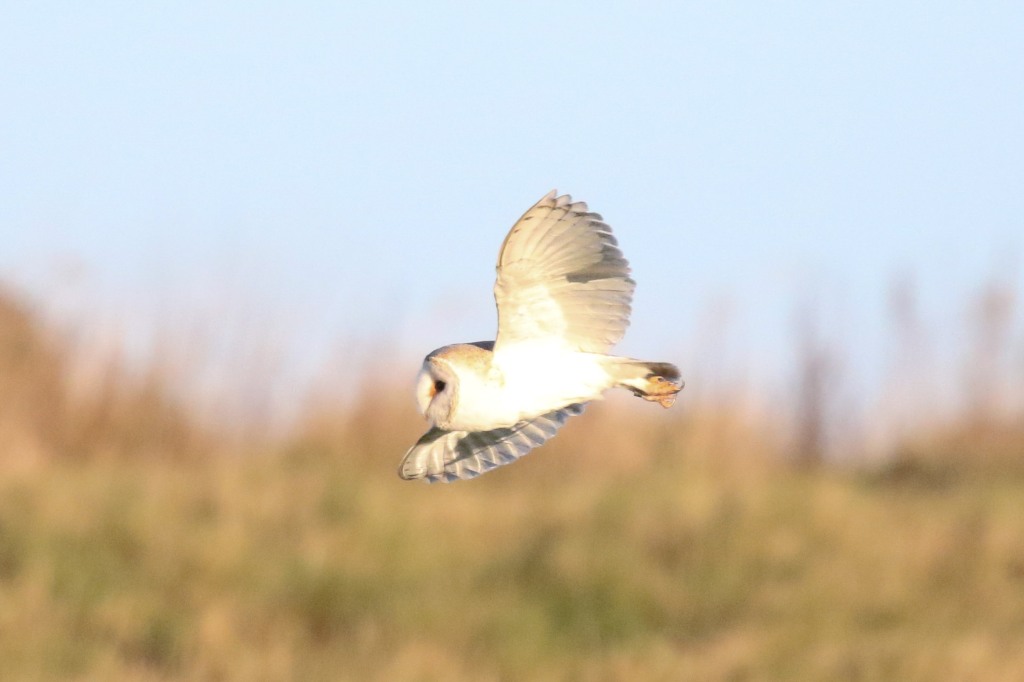
The Barn Owl flew away to our left and suddenly dropped sharply down into the grass in among some big clumps of brambles. Presumably it had caught something, because it stayed down for some time. Eventually we thought it had come up and flown back through the trees behind. We hopped back in the minibus and had a quick look, but there was no further sign of it so we moved on.
Our next target was Tawny Owl. For several years, we have been to look for one which regularly roosts in a tree hole. It had become more erratic in its appearances, but after seeing it successfully in recent days, we were hopeful as we walked up the edge of the field. When we got there though, the hole was bare. Very disappointing! We would have to try to see one at dusk instead. We walked back to the minibus.
It was now mid-morning and the chances for finding owls would be receding. We drove back down to the coast road and along to Cley. There had been a Waxwing for the last couple of day’s in the garden of some local birders and their neighbours had given permission for people to view from their front lawn so as not to disturb it. We parked at the end of Beach Road and walked over to where a couple of people were watching it, feeding on guelder rose berries.
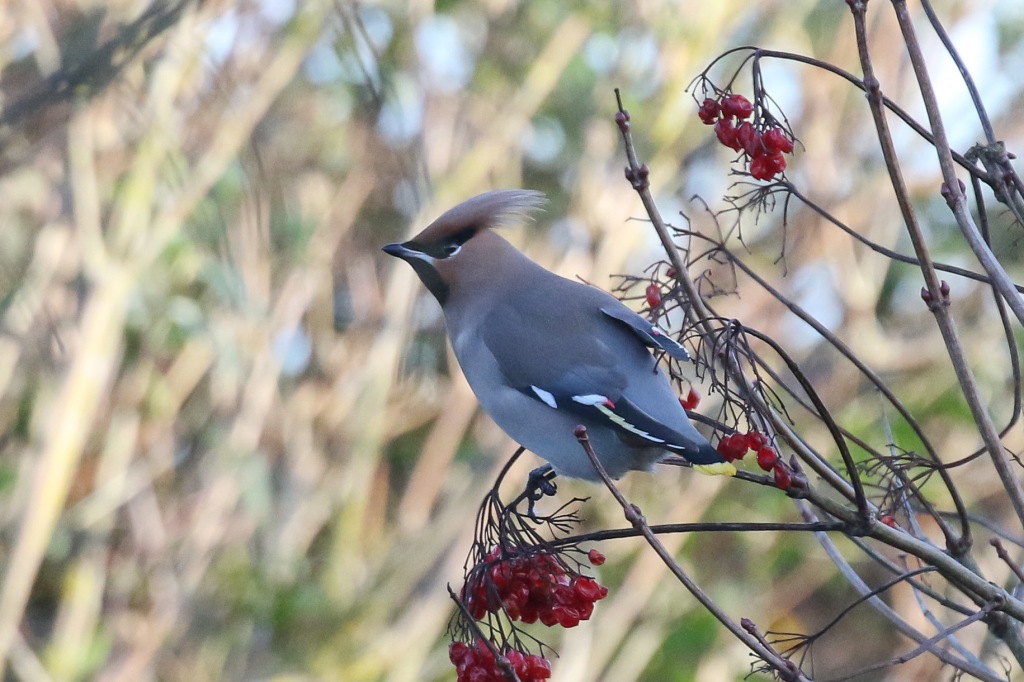
Waxwings are always crowd pleasers, with their extravagant crests, black masks and bibs, and colourful details – yellow and white markings in the wings with waxy red tips and a bright yellow tip to the tail. They are irruptive winter visitors here from Scandinavia. It has been a poor winter for them here, probably due to an abundance of berries in their homelands this year, so it is extra nice to be able to catch up with one.
There was still an hour or so before lunch, so we drove round to the East Bank for a walk. There was a nice selection of ducks on the grazing marshes, Wigeon, Teal and Shoveler, so we got them in the scope for a closer look in the sunshine. Stunning in close up, with their intricate plumage details, as was the superficially plain looking Gadwall a little further up, on the Serpentine.
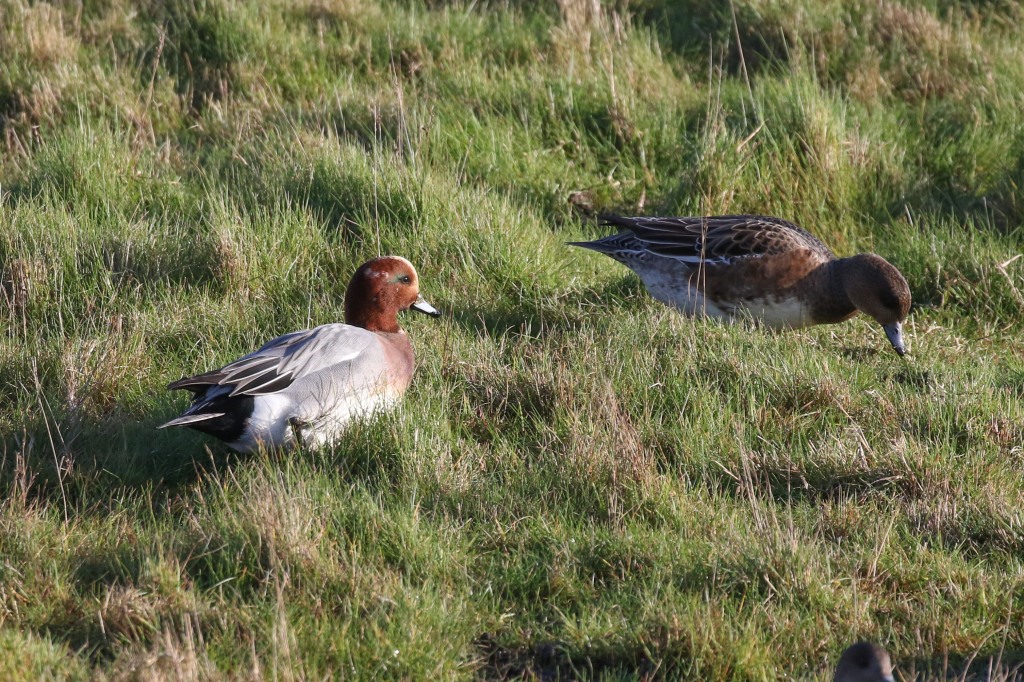
A Kingfisher shot past over the grazing marsh and disappeared in by the reeds further up. We walked on to see if we could find it, but before we could get there it flew again, up over the reeds and dropped towards the main drain. When we got to the sluice, we scanned both side but there was no sign of it. We could see a few Little Grebes on the water.
There were more ducks on the brackish pools, including a smart drake Pintail, busy upending and showing off its pin-shaped central tail feathers. There were a few waders about too – Redshanks and Curlew, and a single Ringed Plover on the shingle island on Arnold’s Marsh. We couldn’t come all this way and not have a quick look at the sea – although there were just a few gulls and Cormorants out here today.
On our walk back, we stopped to admire a Lapwing on the grazing marsh in the sunshine. When everything flushed, we looked up to see a Marsh Harrier drifting in high overhead. We had a quick look at the feeders at Walsey Hills. There were just a few Blue Tits initially, but a few Goldfinches and Greenfinches drifted back in. A Coal Tit put in a very brief appearance too.
Then we headed round to the Visitor Centre for lunch and a welcome hot drink. It was great to sit and look out across the marshes in the sunshine today – it didn’t feel like early January! There were a few birds to see too – a few Avocets out on Pat’s Pool, a couple of Marsh Harriers now over the reedbed. A flock of Brent Geese came up off the marshes and headed inland to feed, coming right over our heads chattering away.
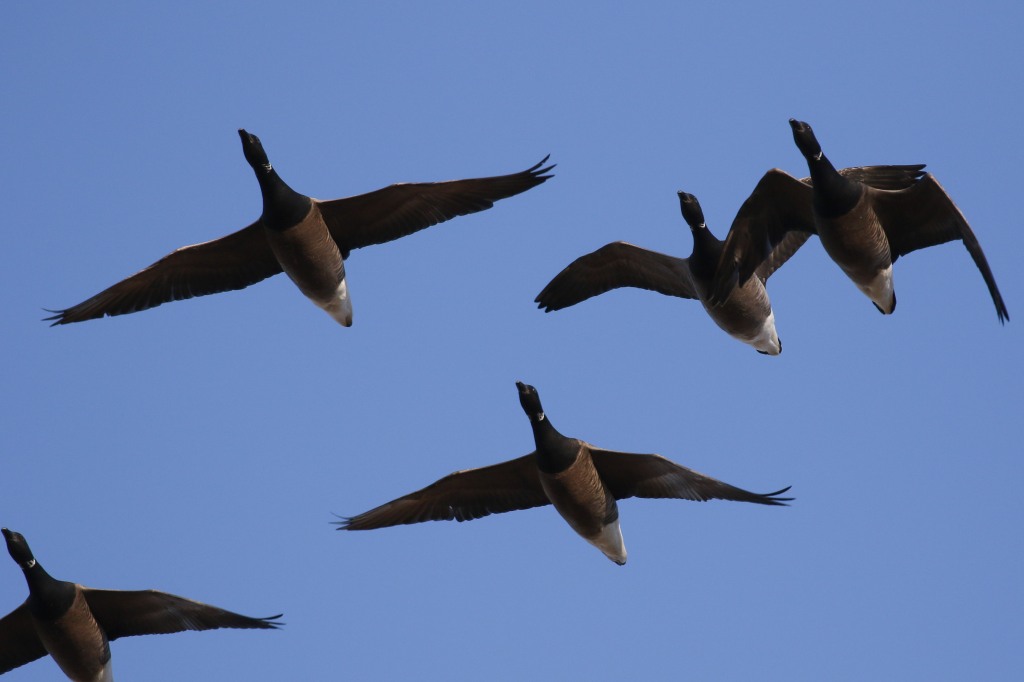
There seems to be a distinct lack of Short-eared Owls in North Norfolk this winter. There had been one regularly here up until mid-December but no reports since, so with the weather perfect this afternoon, we decided to check out where it had been seen most often just in case. A quick drive east to Salthouse Beach Road and back and then down to the beach at Cley failed to produce anything. So we headed round to Blakeney Freshes to try there.
It was a lovely walk out along the bank. We could hear Bearded Tits pinging in the reeds and stopped to look at a Little Egret and a Curlew feeding in the marshes along the Glaven Channel. There were a couple of Common Buzzards, a male Marsh Harrier and a Kestrel out on the trees and fence posts. A Fieldfare dropped in to the top of one of the bushes.
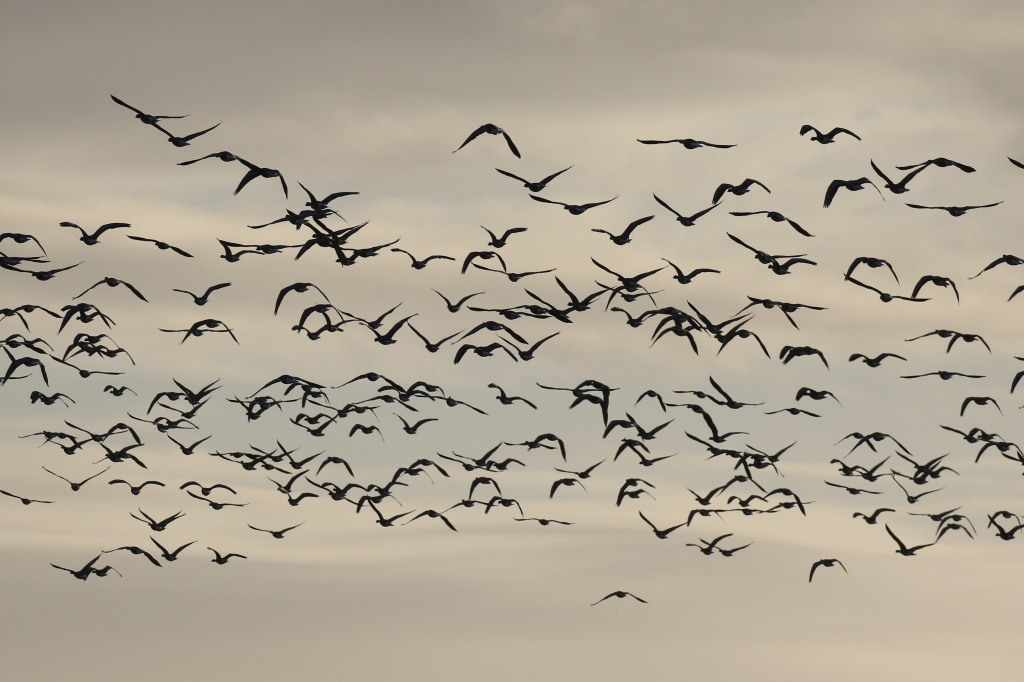
We could hear the yelping calls of Pink-footed Geese, and a little further up we found them loafing down in the long grass. We had a look through the scope, though we couldn’t see their pink legs and feet. As we walked on up to the corner, they all took off, several hundred birds flying up calling into the low sunlight. We watch them fly inland to feed, dropping down again into the fields behind Cley village, one of the sights and sounds of a Norfolk winter.
There were some lovely Teal gathered on the far bank of the Glaven channel which looked stunning in the late sunshine, as did a Lapwing on the mud nearby. We stopped to admire them through the scope. Three small Dunlin dropped in too, before the Lapwing took off and took them with it.
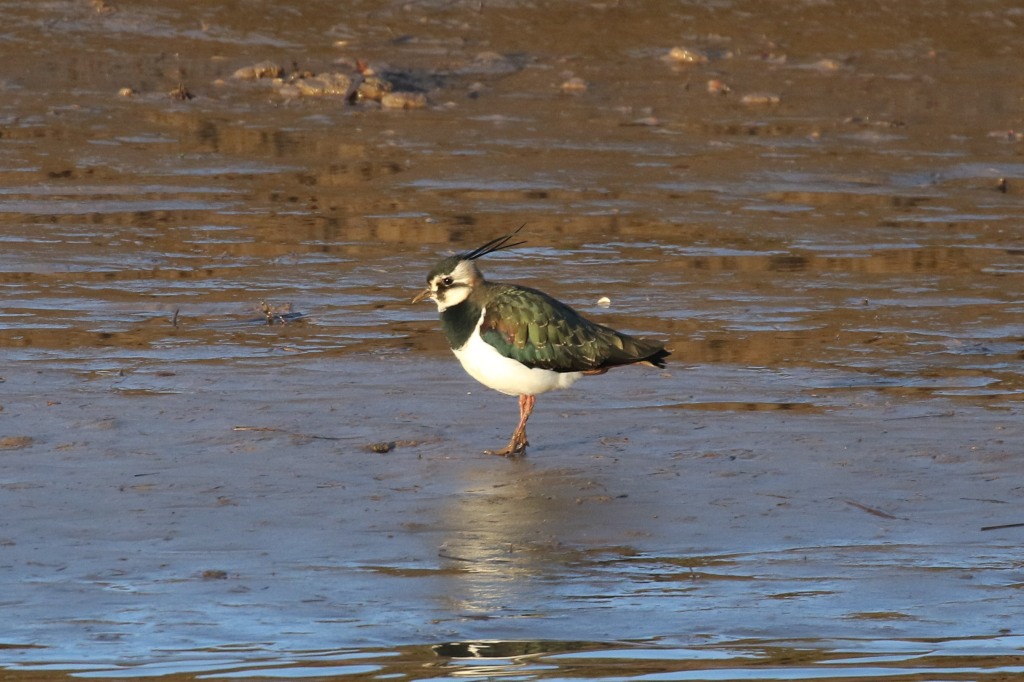
Despite the perfect conditions, there were no owls out hunting this afternoon though, not even a Barn Owl today. Most owls will try to avoid hunting in the daytime, unless they have to – if they are hungry or have young to feed. There seems to be a distinct shortage of Barn Owls at the moment, but it is unclear whether they are just hunting at night – the weather has been relatively clement through the winter so far, with few frosts, so food may well still be relatively plentiful. However, after the snow in February 2021 followed by a very wet spring it was certainly a very poor breeding season for them last year. Hopefully the poor showing at the moment is not a sign that the population has taken a significant hit.
We had a drive round where we had seen the Barn Owl earlier this morning, but there were none out there either. Then we headed inland to try our luck for Tawny Owls. As we got out of the minibus, we could already hear one hooting and soon their was quite a lot of noise coming from further up the path – two males hooting and a female too.
As we walked up, one of the group saw a Tawny Owl move deep in the wood but unfortunately it was only perched for a few seconds and flew again before everyone could get onto it. One was still hooting a little further up and as we started to walk up to look for it, what was presumably the same Tawny Owl flew back and landed in the same tree. Again, frustratingly, it didn’t stay put though, and they moved deeper into the wood.
As we walked back towards the minibus, one of the Tawny Owls was now hooting close to where we had parked. A third male was hooting further over and they a female started calling too. Unfortunately it was getting too dark to see them now, but it was still great just to listen to them hooting in the last of the light. Then it was time to call it a day and head for home.








